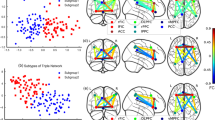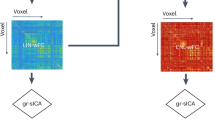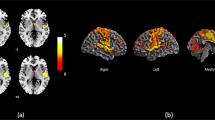Abstract
Functional brain scans have shown that connectivity alterations are strongly associated with the first episode of psychosis, yet it is not well understood whether these alterations vary with the clinical status of patients at the time of scanning. This cross-sectional study aimed to identify brain connectivity properties that differentiate remitting and non-remitting early psychosis (EP) patients from healthy controls and to explore the mechanisms underlying these differences. To this end, we analyzed resting-state fMRI and DSI data from 88 EP patients categorized by their remission ability after the first episode of psychosis. We focused on differences between stage III remitting–relapsing (EP3R) and stage III non-remitting (EP3NR) patients. Opposing functional connectivity (FC) alterations were observed: EP3NR patients exhibited lower FC compared with controls, while EP3R patients showed higher FC, possibly reflecting compensatory mechanisms. Whole-brain network modeling revealed lower local stability affecting the ability to regulate the flow of stimuli across the network in stage III patients, particularly in EP3R, which may indicate an adaptation to impaired network conductivity. These findings highlight subgroup-specific brain alterations and underscore the importance of considering this source of heterogeneity in psychosis research.
This is a preview of subscription content, access via your institution
Access options
Subscribe to this journal
Receive 12 digital issues and online access to articles
$79.00 per year
only $6.58 per issue
Buy this article
- Purchase on SpringerLink
- Instant access to full article PDF
Prices may be subject to local taxes which are calculated during checkout






Similar content being viewed by others
Data availability
The dataset used in the current study can be accessed only with a data sharing agreement with the Lausanne University Hospital and University of Lausanne (CHUV-UNIL) and is available from the corresponding author on reasonable request.
Code availability
The code used in this study is available via GitHub at https://github.com/LudoMana/NATMH-23-1084A.
References
Catalan, A. et al. Proportion and predictors of remission and recovery in first-episode psychosis:systematic review and meta-analysis. Eur. Psychiatry 64, e69 (2021).
Lally, J. et al. Remission and recovery from first-episode psychosis in adults: systematic review and meta-analysis of long-term outcome studies. Br. J. Psychiatry 211, 350–358 (2017).
Álvarez-Jiménez, M., Parker, A. G., Hetrick, S. E., McGorry, P. D. & Gleeson, J. F. Preventing the second episode: a systematic review and meta-analysis of psychosocial and pharmacological trials in first-episode psychosis. Schizophr. Bull. 37, 619–630 (2011).
Fava, G. A. & Kellner, R. Staging: a neglected dimension in psychiatric classification. Acta Psychiatr. Scand. 87, 225–230 (1993).
McGorry, P. D., Hickie, I. B., Yung, A. R., Pantelis, C. & Jackson, H. J. Clinical staging of psychiatric disorders: a heuristic framework for choosing earlier, safer and more effective interventions. Aust. N. Z. J. Psychiatry 40, 616–622 (2006).
McGorry, P. D., Nelson, B., Goldstone, S. & Yung, A. R. Clinical staging: a heuristic and practical strategy for new research and better health and social outcomes for psychotic and related mood disorders. Can. J. Psychiatry 55, 486–497 (2010).
McGorry, P. & Van Os, J. Redeeming diagnosis in psychiatry: timing versus specificity. Lancet 381, 343–345 (2013).
Baumann, P. S., Marion-Veyron, R., Bardy, S., Solida, A. & Conus, P. Beyond clinical staging of psychiatric disorders. Lancet Psychiatry 2, e27 (2015).
Shah, J. L. et al. Transdiagnostic clinical staging in youth mental health: a first international consensus statement. World Psychiatry 19, 233–242 (2020).
Bartholomeusz, C. F. et al. Structural neuroimaging across early-stage psychosis: aberrations in neurobiological trajectories and implications for the staging model. Aust. N. Z. J. Psychiatry 51, 455–476 (2017).
McGorry, P. et al. Biomarkers and clinical staging in psychiatry. World Psychiatry 13, 211–223 (2014).
Peralta, V. et al. A clinical staging model of psychotic disorders based on a long-term follow-up of first-admission psychosis: a validation study. Psychiatry Res. 322, 115109 (2023).
Gupta, T. & Mittal, V. A. Advances in clinical staging, early intervention, and the prevention of psychosis. F1000 Faculty Rev. 8, 2027 (2019).
Raballo, A. & Larøi, F. Clinical staging: a new scenario for the treatment of psychosis. Lancet 374, 365–367 (2009).
Martinuzzi, E. et al. Stratification and prediction of remission in first-episode psychosis patients: the OPTiMiSE cohort study. Transl. Psychiatry 9, 20 (2019).
Yung, A. R. & McGorry, P. D. Prediction of psychosis: setting the stage. Br. J. Psychiatry 191, s1–s8 (2007).
Golay, P. et al. Six months functional response to early psychosis intervention program best predicts outcome after three years. Schizophr. Res. 238, 62–69 (2021).
Emsley, R., Chiliza, B., Asmal, L. & Harvey, B. H. The nature of relapse in schizophrenia. BMC Psychiatry 13, 50 (2013).
Friston, K. J. & Frith, C. D. Schizophrenia: a disconnection syndrome? Clin. Neurosci. 3, 89–97 (1995).
Pettersson-Yeo, W., Allen, P., Benetti, S., McGuire, P. & Mechelli, A. Dysconnectivity in schizophrenia: where are we now? Neurosci. Biobehav. Rev. 35, 1110–1124 (2011).
Kelly, S. et al. Widespread white matter microstructural differences in schizophrenia across 4322 individuals: results from the ENIGMA Schizophrenia DTI Working Group. Mol. Psychiatry 23, 1261–1269 (2018).
Klauser, P. et al. White matter alterations between brain network hubs underlie processing speed impairment in patients with schizophrenia. Schizophr. Bull. Open 2, sgab033 (2021).
Fornito, A. & Bullmore, E. T. Reconciling abnormalities of brain network structure and function in schizophrenia. Curr. Opin. Neurobiol. 30, 44–50 (2015).
Fitzsimmons, J., Kubicki, M. & Shenton, M. E. Review of functional and anatomical brain connectivity findings in schizophrenia. Curr. Opin. Psychiatry 26, 172–187 (2013).
Fornito, A., Zalesky, A., Pantelis, C. & Bullmore, E. T. Schizophrenia, neuroimaging and connectomics. Neuroimage 62, 2296–2314 (2012).
Griffa, A. et al. Brain connectivity alterations in early psychosis: from clinical to neuroimaging staging. Transl. Psychiatry 9, 62 (2019).
Deco, G., Kringelbach, M. L., Jirsa, V. K. & Ritter, P. The dynamics of resting fluctuations in the brain: metastability and its dynamical cortical core. Sci. Rep. 7, 3095 (2017).
López-González, A. et al. Loss of consciousness reduces the stability of brain hubs and the heterogeneity of brain dynamics. Commun. Biol. 4, 1037 (2021).
Cabral, J., Hugues, E., Kringelbach, M. L. & Deco, G. Modeling the outcome of structural disconnection on resting-state functional connectivity. Neuroimage 62, 1342–1353 (2012).
Yang, G. J. et al. Altered global signal topography in schizophrenia. Cereb. Cortex 27, 5156–5169 (2017).
Yang, G. J. et al. Altered global brain signal in schizophrenia. Proc. Natl Acad. Sci. USA 111, 7438–7443 (2014).
Mana, L. et al. Using in silico perturbational approach to identify critical areas in schizophrenia. Cereb. Cortex https://doi.org/10.1093/cercor/bhad067 (2023).
Deserno, L., Sterzer, P., Wüstenberg, T., Heinz, A. & Schlagenhauf, F. Reduced prefrontal–parietal effective connectivity and working memory deficits in schizophrenia. J. Neurosci. 32, 12–20 (2012).
Krystal, J. H. et al. Impaired tuning of neural ensembles and the pathophysiology of schizophrenia: a translational and computational neuroscience perspective. Biol. Psychiatry 81, 874–885 (2017).
Deco, G. & Jirsa, V. K. Ongoing cortical activity at rest: criticality, multistability, and ghost attractors. J. Neurosci. 32, 3366–3375 (2012).
Werner, G. Metastability, criticality and phase transitions in brain and its models. Biosystems 90, 496–508 (2007).
Muñoz, M. A. Colloquium: criticality and dynamical scaling in living systems. Rev. Mod. Phys. 90, 31001 (2018).
López-González, A. Model-Based Analyses of Spatiotemporal Brain Activity During Resting-State and Low-Level States of Consciousness (Universitat Pompeu Fabra, 2021).
Stephan, K. E., Friston, K. J. & Frith, C. D. Dysconnection in schizophrenia: from abnormal synaptic plasticity to failures of self-monitoring. Schizophr. Bull. 35, 509–527 (2009).
Kraguljac, N. V. et al. Neuroimaging biomarkers in schizophrenia. Am. J. Psychiatry 178, 509–521 (2021).
Silver, H. & Feldman, P. Evidence for sustained attention and working memory in schizophrenia sharing a common mechanism. J. Neuropsychiatry 17, 391–398 (2005).
Lechner, S. & Northoff, G. Temporal imprecision and phase instability in schizophrenia resting state EEG. Asian J. Psychiatry 86, 103654 (2023).
Cabral, J., Kringelbach, M. L. & Deco, G. Functional graph alterations in schizophrenia: a result from a global anatomic decoupling? Pharmacopsychiatry 45, 57–65 (2012).
Wang, Y., Hu, X. & Li, Y. Investigating cognitive flexibility deficit in schizophrenia using task-based whole-brain functional connectivity. Front. Psychiatry 13, 1069036 (2022).
Driesen, N. R. et al. Relationship of resting brain hyperconnectivity and schizophrenia-like symptoms produced by the NMDA receptor antagonist ketamine in humans. Mol. Psychiatry 18, 1199–1204 (2013).
Krystal, J. H. et al. NMDA receptor antagonist effects, cortical glutamatergic function, and schizophrenia: toward a paradigm shift in medication development. Psychopharmacology 169, 215–233 (2003).
Horne, C. M. et al. Cognitive control network connectivity differentially disrupted in treatment resistant schizophrenia. Neuroimage Clin. 30, 102631 (2021).
Yang, G. J. et al. Functional hierarchy underlies preferential connectivity disturbances in schizophrenia. Proc. Natl Acad. Sci. USA 113, E219–E228 (2016).
Wilson, H. R. & Cowan, J. D. Excitatory and inhibitory interactions in localized populations of model neurons. Biophys. J. 12, 86068-5 (1972).
Montbrió, E. & Pazó, D. Exact mean-field theory explains the dual role of electrical synapses in collective synchronization. Phys. Rev. Lett. 125, 248101 (2020).
Herzog, R. et al. Neural mass modeling for the masses: democratizing access to whole-brainbiophysical modeling with FastDMF. Netw. Neurosci. 8, 1590–1612 (2024).
Pfeffer, T. et al. Circuit mechanisms for the chemical modulation of cortex-wide network interactions and behavioral variability. Sci. Adv. 7, eabf5620 (2021).
Baumann, P. S. et al. Treatment and early intervention in psychosis program (TIPP-Lausanne): implementation of an early intervention programme for psychosis in Switzerland. Early Interv. Psychiatry 7, 322–328 (2013).
Hickie, I. B. et al. Applying clinical staging to young people who present for mental health care. Early Interv. Psychiatry 7, 31–43 (2013).
Alameda, L. et al. Childhood sexual and physical abuse: age at exposure modulates impact on functional outcome in early psychosis patients. Psychol. Med. 45, 2727–2736 (2015).
Andreasen, N. C. et al. remission in schizophrenia: proposed criteria and rationale for consensus. Am. J. Psychiatry 162, 441–449 (2005).
Alemán-Gómez, Y., Arribas-Gil, A., Desco, M., Elías, A. & Romo, J. Depthgram: visualizing outliers in high-dimensional functional data with application to fMRI data exploration. Stat. Med. 41, 2005–2024 (2022).
Iglesias, J. E. et al. A computational atlas of the hippocampal formation using ex vivo, ultra-high resolution MRI: application to adaptive segmentation of in vivo MRI. Neuroimage 115, 117–137 (2015).
Najdenovska, E. et al. In-vivo probabilistic atlas of human thalamic nuclei based on diffusion-weighted magnetic resonance imaging. Sci. Data 5, 180270 (2018).
Iglesias, J. E. et al. Bayesian segmentation of brainstem structures in MRI. Neuroimage 113, 184–195 (2015).
Glerean, E., Salmi, J., Lahnakoski, J. M., Ja, I. P. & Sams, M. Functional magnetic resonance imaging phase synchronization as a measure of dynamic functional connectivity. Brain Connect. 2, 91–101 (2012).
Cocchi, L. et al. Disruption of structure-function coupling in the schizophrenia connectome. Neuroimage Clin. 4, 779–787 (2014).
Demirtas, M. et al. Hierarchical heterogeneity across human cortex shapes large-scaleneurodynamics. Neuron 101, 1181–1194.e13 (2019).
Rolls, E. T. et al. Beyond the disconnectivity hypothesis of schizophrenia. Cereb. Cortex 30, 1213–1233 (2019).
Deco, G. et al. Dynamical consequences of regional heterogeneity in the brain’s transcriptional landscape. Sci. Adv. 7, 29 (2021).
Ponce-Alvarez, A. & Deco, G. The Hopf whole-brain model and its linear approximation. Sci. Rep. 14, 2615 (2024).
Perl, Y. S. et al. The impact of regional heterogeneity in whole-brain dynamics in the presence of oscillations. Netw. Neurosci. 7, 632–660 (2022).
Jakub, V. et al. Brain dynamics predictive of response to psilocybin for treatment-resistant depression. Brain Commun. https://doi.org/10.1093/braincomms/fcae049 (2024).
Acknowledgments
The project that gave rise to these results received the support of a fellowship from ‘la Caixa’ foundation (ID 100010434). The fellowship code is LCF/BQ/DI19/11730048) and financed L.M.’s work. In addition, G.D., M.V.-V. and L.M. were supported by the Human Brain Project Specific Grant Agreement 3 Grant agreement no. 945539 financed by the European Commission and by the Spanish Research Project ref. PID2019-105772GB-I00/AEI/10.13039/501100011033, financed by the Spanish Ministry of Science, Innovation and Universities (MCIU), State Research Agency (AEI). This last institution also financed M.V.-V through the grant/award number PID2020-119072RA-I00/AEI/10.13039/501100011033. G.D. was supported by the project NEurological MEchanismS of Injury, and Sleep-like cellular dynamics (NEMESIS) (ref. 101071900) funded by the EU ERC Synergy Horizon Europe; by the NODYN Project PID2022-136216NBI00 funded by MICIU/AEI/10.13039/501100011033 and by ‘ERDF A way of making Europe,’ ERDF, EU; by the AGAUR research support grant (ref. 2021 SGR 00917) funded by the Department of Research and Universities of the Generalitat of Catalunya; and by the project eBRAIN-Health—Actionable Multilevel Health Data (ID 101058516), funded by the EU Horizon Europe. A.L.-G. was supported by Swiss National Science Foundation Sinergia grant no. 170873. L.A.E. was supported by a research grant of University of Lausanne, Switzerland. L.A. was supported by a fellowship of the Adrian and Simone Frutiger Foundation and from Carigest Foundation. P.K. was supported by a fellowship from the Adrian and Simone Frutiger Foundation. Y.A.-G. and P.H. were financially supported by Swiss National Science Foundation grant no. 320030-197787. None of the funders had any role in the conceptualization, design, data collection, analysis, decision to publish or preparation of the manuscript.
Author information
Authors and Affiliations
Contributions
R.J., P.S.B., P.K., P.C., L.A. and L.A.E. collected data and performed clinical evaluation. P.S.B. and P.K. assessed the clinical staging. P.H. and Y.A.-G. collected and pre-processed the neuroimaging data. A.L.-G., L.M., M.V.-V. and G.D. designed the research. L.M., A.L.-G. and M.V.-V. analyzed the data L.M. and M.V.-V. wrote the manuscript. M.V.-V. and G.D. supervised the research. All authors contributed to the editing of the manuscript.
Corresponding author
Ethics declarations
Competing interests
The authors declare no competing interests.
Peer review
Peer review information
Nature Mental Health thanks Leanne Williams and the other, anonymous, reviewer(s) for their contribution to the peer review of this work.
Additional information
Publisher’s note Springer Nature remains neutral with regard to jurisdictional claims in published maps and institutional affiliations.
Supplementary information
Supplementary Information
Supplementary Figs. 1–8, Tables 1–3, Methods and Results.
Rights and permissions
Springer Nature or its licensor (e.g. a society or other partner) holds exclusive rights to this article under a publishing agreement with the author(s) or other rightsholder(s); author self-archiving of the accepted manuscript version of this article is solely governed by the terms of such publishing agreement and applicable law.
About this article
Cite this article
Mana, L., López-González, A., Alemán-Gómez, Y. et al. Subgroup-specific brain connectivity alterations in early stages of psychosis. Nat. Mental Health 3, 408–420 (2025). https://doi.org/10.1038/s44220-025-00394-7
Received:
Accepted:
Published:
Issue date:
DOI: https://doi.org/10.1038/s44220-025-00394-7



